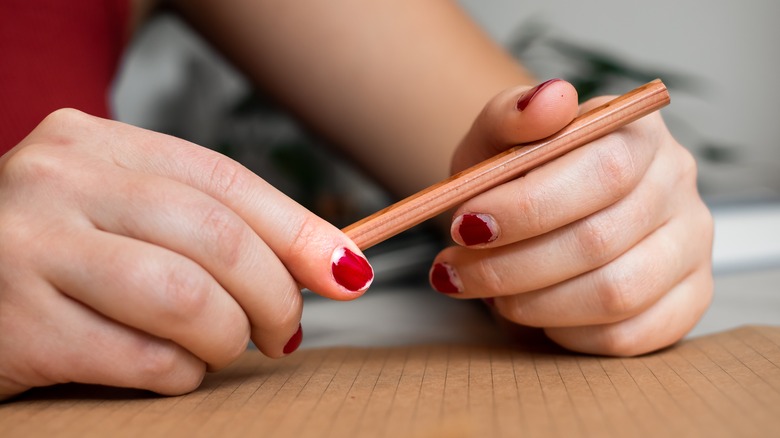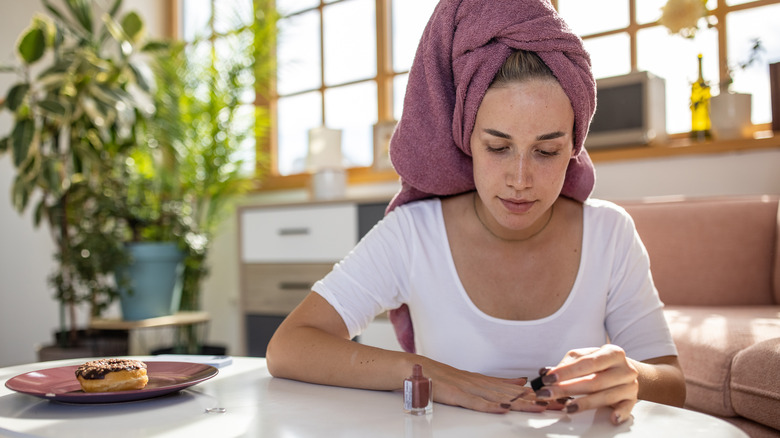The Easiest Ways To Stop Your Nail Polish From Chipping
If you're a fan of nail polish, you've probably run into one particular issue a handful of times: chipping. It happens to the best of us. You find yourself rocking a gorgeous new mani (maybe something bold like the eye-catching mixed metals trend) but then you look down to notice that you're missing a chunk of color from your left pointer fingernail. Unless you have that exact polish with you, it can be pretty difficult to hide it, and even if you do have the polish to hand, painting over the chip and making your mani look seamless isn't an easy feat.
But you'll be happy to know that it doesn't have to be that way. Even if you prefer traditional polishes, which are more prone to chipping over something like a classic gel or a hard gel manicure, there are a couple of super simple things you can do to keep those pesky chips and bay. We're breaking them down so you can start rocking some of the trendiest nail looks the way they're supposed to be; chip-free!
Keep your hands moisturized and paint in thin layers
It's not all up to the polish you're using to prevent chips — it's just as important to make sure your hands and nails are properly moisturized. That's because dry, brittle nails are more prone to chipping. Skyy Hadley, celebrity manicurist and As U Wish Nail Spa owner, told Glamour that regularly applying cuticle oil is one of the best ways to keep your nails moisturized. She even recommended applying it every couple of days, sharing, "This will restore moisture and also help prevent chipping and splitting."
Once your nails are nice and moisturized, another solid tip for when you're painting comes from Sarah Gibson Tuttle, founder and CEO of Olive & June. She told Byrdie that the thinner your coats and the more time you give them to dry, the less likely your polish will be to chip. That's because thick, gloopy layers of polish won't dry properly (at least not quickly), making the polish more likely to chip off. Not to mention, this kind of application can also cause bubbles to form in your polish. How long you should wait in between layers depends on the polish you're using, but holding off for around two to five minutes is a good idea. And, with that said, don't shake your polish bottle before applying it either. That may result in bubbles, which will then go on your nails and chip.
Don't forget a base and top coat
Another way to keep those chips away is to make sure you're both prepping and finishing your nails properly. A good base coat applied under your nail polish will help to provide a smooth base for your nails. That means your polish will apply more evenly and, therefore, will be less likely to chip over things like ridges or nail splits. Base coats can also ensure the polish sticks better to your nails, preventing not only chipping but peeling as well. Though all good base coats should do this, if you're specifically worried about chipping, it's worth trying a base coat that specifically states it's anti-chip.
Applying a top coat is just as important as your base coat, as they're designed to seal in your polish. Think of it like applying a setting spray over your makeup, except a top coat will also help create a smoother, protective layer to stop things like chipping, scratches, or peeling. But, while applying top coats can be time-consuming, take your time and get even layers. If you don't, Sally Hansen's global color ambassador Madeline Poole warned Glamour that you could actually end up causing more chipping. "Topcoats tighten as they dry, which is what can cause those little ridges if you don't put it on properly," she explained, noting that those ridges will be more prone to chips.


